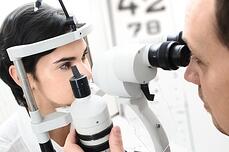This guest post is written by Katie Matlack of Software Advice.
This article is based on the interviews conducted with various respondents (four ophthalmologists and a practice manager) within one specialty, Ophthalmology, who had strong opinions on what characteristics were the most important to look for in an Ophthalmology EMR Software solution. Here are the major takeaways.
1) It’s important that your solution can handle large image files efficiently.
You probably already know that ophthalmologists deal with lots of very high-resolution images of the eye. Since the file sizes for those images can be quite large, without the right solution your image files could slow down the rest of your EMR system. Dr. Dean Calson of Eye Associates of Colorado Springs told me that his system allows him to run his images off a second server, eliminating any possible competition for processing power between his images and the rest of his EMR. Dr. Valla Djafari of the Texas Retina Institute, on the other hand, noted that his Web-based EMR allowed him to use the wireless network of whatever office he was working at to easily access the files he needed. As a more mobile doctor who worked at multiple locations that referred patients to him, he stressed the ease of the Web-based option for its convenience as well.
2) Interconnectivity with eye measurement tools is key.
If your EMR platform can connect directly to your testing equipment, your life will be made a lot easier. Dr. Byron Tabbut of Wheaton Eye Clinic mentioned that having all information available from one source--your EMR--can save you from “having to hunting and pecking all over” for data from various different places.
On the topic of interconnectivity, here’s a useful tip that one ophthalmologist, Dr. Walter Harris of Rittenhouse Eye Associates, shared. It’s related to pricing questions you should keep in mind when speaking with vendors:
“It’s worth the money for a system to be able to intersect with your testing equipment. But different companies will charge differently for this ability; one might offer an unlimited option, while others might charge you per piece of equipment.”
Dr. Harris recommended asking each vendor about the pricing structure of the feature, and also suggested having a list of all your exam equipment in hand when you meet with vendors.
3) Accessing key patient data and history all at once can save time and improve care.
It’s probably no surprise that you should look for an EMR’s ability to show you key data, such as a patient’s historical intraocular pressure, for easy reference. But it bears repeating. Some EMRs can calculate trends for you, while others can simply ensure that data from 20 years of paper is available in the same electronic system that recent data is stored in. EMRs can also provide helpful data to you in the form of showing trends in how a patient’s eye health responds to medications. According to Frank Bellocchio, the Ophthalmic Technician with Dr. Harris, systems that display the average intraocular pressure of a patient together with historical medication data can help you make diagnoses and develop treatment plans.
4) Think long-term sustainability if you want to avoid having to pay for a new solution again soon.
One fascinating point Dr. Harris made was related to a comment made at a recent annual meeting of the Academy of Ophthalmology, where a German ophthalmologist had advised his U.S. peers about what to look for in an EMR. Germany began switching to EMRs about 10 years ago, and lessons learned from their experience are applicable to ophthalmologists in the United States today.
Said Dr. Harris: “Ten years ago in Germany, there were 67 EMR vendors for ophthalmologists. Today, there are six. Half of the practices that bought an EMR had to buy one again, or twice.
He advised those in the fact-finding phase of research to look for a company with a commitment to ophthalmology, not one that might close up a few years out.” He suggests looking for vendors with many years of ophthalmology experience, to find ones that would be the most knowledgeable and time-tested.
This article discusses what ophthalmologists on the lookout for the right ophthalmology EMR solution should keep in mind. You can view the original post this story is based on here. Katie writes for the Software Advice blog about various topics related to medical software, with particular interest in EMRs and patient-centered health information technology. She is a graduate of Yale University, where she majored in American Studies.






